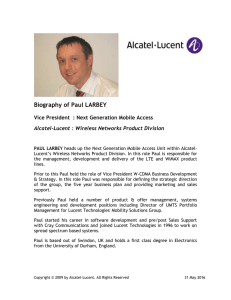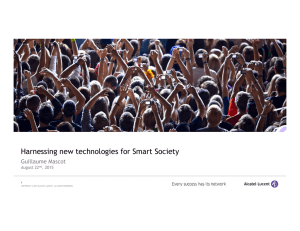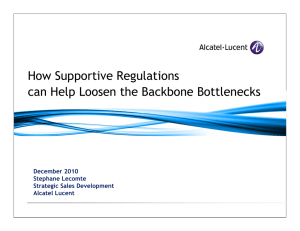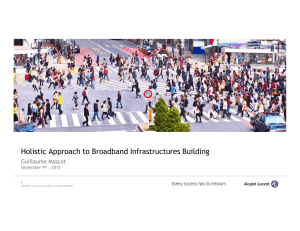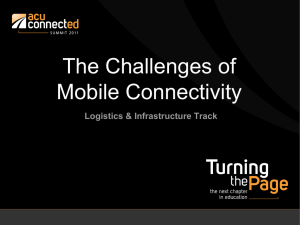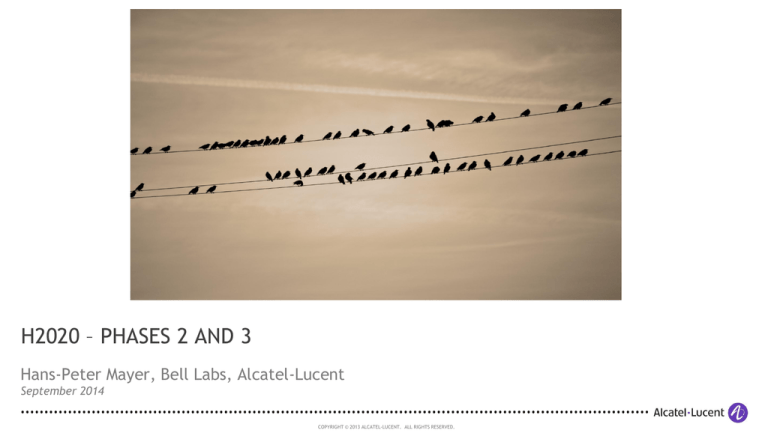
H2020 – PHASES 2 AND 3
Hans-Peter Mayer, Bell Labs, Alcatel-Lucent
September 2014
COPYRIGHT © 2013 ALCATEL-LUCENT. ALL RIGHTS RESERVED.
DRIVERS FOR 5G ADOPTION
Services
delivered /
users served:
Efficiency
improvements
Broadband
TCO
Machines
Energy
Security
Spectrum
2
COPYRIGHT © 2014 ALCATEL-LUCENT. ALL RIGHTS RESERVED.
KPIS - WHICH ARE THE 5G DESIGN TARGETS?
3
COPYRIGHT © 2014 ALCATEL-LUCENT. ALL RIGHTS RESERVED.
CAN WE HAVE A SINGLE MULTI-SERVICE AIR INTERFACE?
… YES
Challenge:
Combine broadband and small traffic
Be resource efficient ( energy, spectrum, network)
Low overhead , low complexity, simple terminals
Offer high reliability & low latency options
www.5gnow.eu
Traffic Type
Synch?
Access Type
Properties
I
closed-loop
scheduled
classical high volume data services
II
open-loop
scheduled
HetNet and/or cell edge multi-layered high
data traffic
III
open-loop
sporadic, contention-based
few bits, supporting low latency,
e.g. smartphone apps
IV
open-loop/none*
contention-based
energy-efficient, high latency, few bits
*: none for maximal energy savings at Tx, open-loop for reduced complexity at Rx
4
COPYRIGHT © 2014 ALCATEL-LUCENT. ALL RIGHTS RESERVED.
MORE SPECTRUM: MM-WAVE
WILL IT PROVIDE COVERAGE AT COST?
• Mm- wave for outdoor or indoor access
• Lots of mm-wave spectrum
• Bursty traffic,
High rate …. when covered
Propagation is mainly line of sight Arrays
Cost and energy efficiency
efficient silicon
Dense deployment (overlapping coverage)
Tracking of users needed
Coverage
at cost?
5
COPYRIGHT © 2014 ALCATEL-LUCENT. ALL RIGHTS RESERVED.
NEW EDGE ARCHITECTURE, EXPLOITING VIRTUALIZATION
Federico Boccardi, Osman Aydin, Uwe Doetsch, Torsten Fahldieck, Hans-Peter Mayer:
User-centric architectures: Enabling CoMP via hardware virtualization. PIMRC 2012: 191-196
6
COPYRIGHT © 2014 ALCATEL-LUCENT. ALL RIGHTS RESERVED.
SDN: ONE DEPLOYMENT FOR DIVERGING SERVICES
Create service
specific
virtualized
networks
Enable and
exploit
virtualization
and multitenancy
7
COPYRIGHT © 2014 ALCATEL-LUCENT. ALL RIGHTS RESERVED.
FROM MULTI-RAT TO FUSION OF RAT’S
Broad
voice
band
M2M
Broad
Emergency
services
cast
Xxx
in 2028
heterogeneous services
Legacy RAT to be integrated:
service mapping, handover ..
5G
Wi
Fi
4G
5G
mmW
System sharing
spectrum
instead of spectrum sharing
- Two levels of integration: 5G air interface and system: multi-RAT
- Sharing at system level: framework needed
8
COPYRIGHT © 2014 ALCATEL-LUCENT. ALL RIGHTS RESERVED.
5G – CORE TECHNOLOGIES
9
COPYRIGHT © 2013 ALCATEL-LUCENT. ALL RIGHTS RESERVED.
EU & EC Framework – 5G Infrastructure PPP Highlights
PPP Pre-structuring Model
P8:
5G Holistic Network Architecture
Application
Layers
P13:
5G Network Security and Integrity
P12:
SLM &
Metrics
for
QoS/QoE
P10:
5G Services
E2E
Brokering
and Delivery
P11:
Cognitive Network Management
P9:
Enabling Technologies Unified Control
P16:
Multi-Domain SW Networks
P14:
Virtual Networks Platform
P1:
5G Wireless System Design
• H2020 work
- Topic areas for H2020 call 2 PPP
reflect a long-term program targeting
a standard in 2020
- As a result we see little change in the
basic topics and technologies
themselves
Physical
Layer
P6:
Novel Radio System
Architecture
P7: Backhaul/Fronthaul
Integration
P2:
5G Air Interface
P3:
5G for Massive
MTC
P15:
Service
Program.
and
Orchestr.
P5:
5G
HW/SW
Platforms
P4:
5G mm-Wave
Air Interface
Technology components
http://5g-ppp.eu/wp-content/uploads/2014/03/5G-Infra-PPP_Pre-structuring-Model_v2.0.pdf
10
COPYRIGHT © 2014 ALCATEL-LUCENT. ALL RIGHTS RESERVED.
Note: The size of the Projects boxes does not indicate
the potential size or manpower of Projects
Services
EVOLUTION -- TRANSITION FROM LTE ++ TO 5G
2014
2015
2016
2017
R14
5G
4G
R12
R13
2018
(start SI)
?
R14
2019
2020
R15
R16
R15
R16
2021
Introduction -- SDN/NFV in core and gateways
WRC’18/19
WRC’15
2022
2023
2024
• Main drivers for 5G:
- Extended range of services and use cases
Small traffic, low latency, availability
- Cost, energy and signaling efficiency in the
networks
- Simple and SDN/NFV-compatible architecture
integrating legacy RAT
Conceptual work
Focusing: Evaluation /
integration/ selection
Integration, Engineering, trials
FP7
H2020 Call2 - 5GPPP-
Phase 2
- The focus of the projects should evolve with the maturing of the topics
- Early phase: Conceptual work, scouting
- Focussing phase: Quantitative evaluation, Assessment and selection of the technologies, integration of a
system
- Integration and Engineering phase
- Phasing : Number of people that can drive the process is limited. Phases should stay sequential.
11
COPYRIGHT © 2014 ALCATEL-LUCENT. ALL RIGHTS RESERVED.
GAPS IN THE CURRENT SET OF PROJECTS
• Linkage to evolving an applications community
- Need to track requirements and to link to stakeholders on the applications side
- Allow app stakehoders to “play” with the new possibilities
• Some topic areas will extend or split to allow for deeper coverage
- Introducing more extensive evaluation: modeling, simulation frameworks
- Attaching a targetted prototyping activity to accommodate for sufficient resources
- Deeper coverage of specific topics
• New questions will come up:
- E.g. the impact of virtualization and multi-tenancy on “business” within the network,
accounting is becoming crucial. This has significant regulatory and legal implications.
12
COPYRIGHT © 2014 ALCATEL-LUCENT. ALL RIGHTS RESERVED.
Examples for research questions
resulting from cross-topics
• Cross- projects: Some interactions between the “last” pre-structuring projects
need more in-depth studies
- This is currently being accounted for in bi-lateral interactions between the Px projects
but dedicated studies need to follow
Security aspects of
Virtualization and
Architectures
P8:
5G Holistic Network Architecture
Application
Layers
P13:
5G Network Security and Integrity
P12:
SLM &
Metrics
for
QoS/QoE
P10:
5G Services
E2E
Brokering
and Delivery
P11:
Cognitive Network Management
P9:
Enabling Technologies Unified Control
P16:
Multi-Domain SW Networks
Air interface:
adaptation for MTC
P14:
Virtual Networks Platform
P1:
5G Wireless System Design
P3:
5G for Massive
MTC
Physical
Layer
P6:
Novel Radio System
Architecture
P7: Backhaul/Fronthaul
Integration
P2:
5G Air Interface
Rationalization /
Common modules?
P15:
Service
Program.
and
Orchestr.
P5:
5G
HW/SW
Platforms
Note: The size of the Projects boxes does not indicate
the potential size or manpower of Projects
P4:
5G mm-Wave
Air Interface
Services
Technology components
http://5g-ppp.eu/wp-content/uploads/2014/03/5G-Infra-PPP_Pre-structuring-Model_v2.0.pdf
13
COPYRIGHT © 2014 ALCATEL-LUCENT. ALL RIGHTS RESERVED.
EXTENDED PARTNERSHIP MODELS
- The interest in participation to the PPP projects is much larger than
what they can handle
- Many academic partners would like to join PPP, but cannot be accommodated
- Many non-EU parties seek linkage
- Currently captured in EU-Japan, EU-Korea, EU-China
- This approach does not scale easily, there are many more candidates ….
- Dilemma : If we increase the PPP projects size to accommodate more partners and parties, projects
loose focus and efficiency
- Consider a structured approach, creating a co-operation platform “around” the projects.
14
COPYRIGHT © 2014 ALCATEL-LUCENT. ALL RIGHTS RESERVED.
DEMOS AND PROTOTYPES – GENERAL CONSIDERATIONS
• Demos should show
- The mastering of a technical challenge
- The impact of a new technology
• Realization
- Demos may be pure (software) models, just visualizing properties and impact of a technology
- Can also consist of a prototype plus a human interface to allow for more insight
- This is clearly the preferred type
• De- risking and relevance
- Prototypes should closely relate to the critical research questions of the project
16
COPYRIGHT © 2014 ALCATEL-LUCENT. ALL RIGHTS RESERVED.
DEMOS AND PROTOTYPES – GENERAL CONSIDERATIONS
• Limited effort:
- Prototypes rely on simplifications and abstractions to become viable (e.g. one scenario, few
users)
- Use abstractions for non-relevant parts
- Lack of statistical richness: Generally, prototypes are not a good vehicle to answer
performance questions
(Apart from e.g. peak rates ) since they represent limited numbers of nodes and users
- Realization perspective: Realization of a prototype leads to an implementation view and
related learning. It adds another perspective to research.
17
COPYRIGHT © 2014 ALCATEL-LUCENT. ALL RIGHTS RESERVED.
WHAT WOULD WE SEE IDEALLY ON PROTOTYPING?
Topic
Demo
1 System
D2D links, Dense networks,
Sharing between players
System monitor
Application demo
2 Air Interface
- Air interface integrating broadband and massive small traffic
-Low latency link ( D2D and Infrastructure type)
-High availability link option / extended link budget
Air Interface chain (on air)
Demos with system monitor
and demo applications
3 M2M
Application / use case demo for small traffic,
Including low latency application
Demo applications from
Automotive, smart grid, sensing area,
abstraction of signal processing chain
4 Mm-wave
Outdoor mm-wave link with dynamic tracking of a (pedestrian) user
Fast switching between access points, between umbrella layer and mmwave
Multiple (video) applications over a realtime mm-wave link,
5 Efficient
hardware
Highly efficient broadband transceiver
low-power flexible baseband chain for 5G air IF
Hardware demo w. generated signals,
spectra, power meter
6 Novel
architecture
Dynamic connectivity on a virtualization platform:
Instantiation of RAN functions, creation and deletion of antenna paths,
mobility
System monitor
7 Flexible Front/
Mid- / backhaul
Different distribution options for RAN functions
System monitor
(7 may be combined with 6)
Visualization and experience
18
COPYRIGHT © 2014 ALCATEL-LUCENT. ALL RIGHTS RESERVED.
EVOLUTION OF PROTOTYPE SCOPE
2014
2015
2016
2017
R14
5G
4G
R12
R13
2018
(start SI)
?
R14
2019
2020
R15
R16
R15
R16
2021
2022
2023
2024
Introduction -- SDN/NFV in core and gateways
WRC’18/19
WRC’15
FP7
H2020 Call2 - 5GPPP-
Phase 2
1: Technology components
2: Sub-systems
3: Early System trials
(pre-standard)
• Step1 : Technology components like waveforms and spectra, mm-wave links
• Step2: Sub-systems: multiple complete links, early protocol stack carrying applications
• Step3: Early systems based on preliminary standard and specs
19
COPYRIGHT © 2014 ALCATEL-LUCENT. ALL RIGHTS RESERVED.

